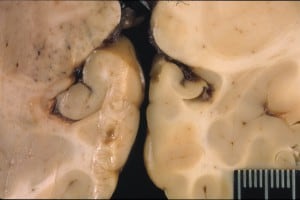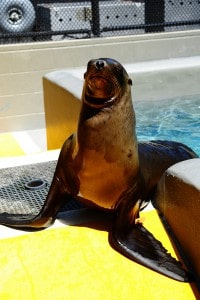Share this article
Toxic Algae Could Be Confusing Stranded Sea Lions
It may take both sides of the brain to find a fish.
Large numbers of sea lions turning up stranded on the California coasts may be suffering from neurotoxic damage caused by blue-green algae blooms, according to new research.
“The ones that end up with damage to the right hippocampus in particular are the ones that are going to have trouble remembering where they are, remembering where their food sources are,” said Charan Ranganath, a neuroscientist at University of California-Davis and senior author of a study published online yesterday in Science. Ranganath added that damage to this region of the brain can also make the animals more susceptible to illness, and more likely to end up stranded on shore.

A photo showing the right and left hippocampus in a sea lion brain. The right hippocampus (the U-shaped parts in the middle) is significantly smaller than the left. Image courtesy of The Marine Mammal Center, Sausalito
Strandings of young sea lions have been occurring in large numbers along the California coast for the last few years. The seals were almost universally undernourished — many of them dead — and earlier this year, biologists noted the strandings could be occurring as a result of anything from changing climate to shifting food availability. But now research points to another potential culprit — the increasing amount of toxic blue-green algae blooms occurring off the coast of the state.
Peter Cook, lead author of the study and then a graduate student at the University of California-Santa Cruz, was working with sea lions that had been stranded on beaches along the coast at The Marine Mammal Center in Sausalito, Calif. He and Ranganath met at a neuroscientist event and ultimately devised a way to adapt a memory test — typically used on rats — to sea lions in a tank.
The test works like this: A sea lion walks through a passage and finds two doors. If it chooses the right door the first time, it will receive a fish. The test is then repeated, but the sea lion must choose the left door the second time. Once the animals learn the system of alternation, the researchers make the sea lion wait longer intervals between tests in order to make it resort to long-term memory.
The researchers already knew which sea lions had a smaller hippocampus based on MRI scans that Cook and others ran on the animals at the rehabilitation center. The ones with damage to those parts of the brain could still learn the rules to the reward system in the tests, but they couldn’t remember which side the fish was on as much as those sea lions without damage.
“That kind of memory is very dependent on the hippocampus,” Ranganath said of long-term memory. This means that sea lions in the wild could be forgetting where the best places to find prey are from one season to the next, resulting in them eventually ending up starving on the beach.
“You can’t help but look at this and see this as a consequence of environmental degradation,”Ranganath said. “It puts not a human face, but a sea lion face on this problem.”
While sea lions don’t eat the algae directly, they feed on smaller fish that do. The algae contains high levels of domoic acid — a neurotoxin that can lead to lesions that damage the hippocampus as they build up over continued exposure, but more research is needed before this is well understood.
“What isn’t well understood yet is the dose response,” Cook said in a release. “We don’t know how heavy the exposure needs to be, or how often repeated, to cause this kind of brain damage, and we don’t know the effects of repeated low-dose exposure.”
But Ranganath said that their findings could help limit future strandings or sea lion deaths as the seals with hippocampus damage are probably not fit to be released into the wild, even though they may appear to have recovered in terms of nourishment.
“Understanding this allows us to better understand whether an animal that gets stranded will survive when you put them back out into the ocean,” he said.
Watch a sea lion go through a memory test. Image Credit: Wharton Media
Header Image: A sea lion being released in California. Image courtesy of The Marine Mammal Center, Sausalito









